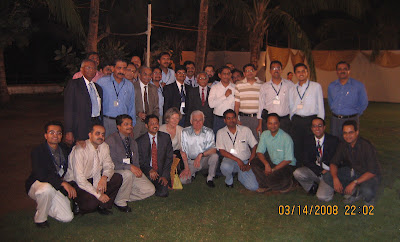What are the treatment options for this 30 year old lady with progressive hemiparesis.
Stereotactic biopsy is suggestive of low grade astrocytoma. Please advise. Am attaching post-GD MRI images.
-Nitin Garg




> From: brmrao1963 To: neurosurgery_ nimhans@. ..:
Sunday, January 18, 2009 11:55:26 AMSubject: [neurosurgery_ nimhans]
Re: Question of the week: Left thalamic low grade astrocytoma
>
Dear Nitin,
The images reveal a multifocallesion which is occupying a spread-out real estate in the ganglionic
and deep grey region abutting the internal capsule. While I do
operate micro surgically on thalamic lesions,the usual indication is
for a single mass. You can use a therapeutic test with dexamethasone
to find out if the weakness is reversible or not. If the deficit is
not reversible with steroids,then it is unlikely that surgery will
do so.In such a scenario, it maybe enough to subject her to
radiation and chemotherapy( some low grade astros do respond to
chemo)taking into consideration QOL issues.If there is a reasonable
chance of reversal of deficit you operate on her(transcallosal Vs
transcortical_ the lesion is spread-out quite laterally and may be
difficult to access transcallosally) . The point to be considered is
that the deficit can be created by a surgical adventure also!If you
have access to DTI please do it to map internal capsule fibers and
their course. If they are involved by the tumor, Surgery will not
have much to offer.
Ravi
To: neurosurgery_ nimhans@. ..: gopalakrishnanms@ ...: Sun, 18 Jan
2009 08:01:34 -0800Subject: Re: [neurosurgery_ nimhans] Re: Question
of the week: Left thalamic low grade astrocytoma
Dear Nitin,
Some questions worth pondering on ...
1. Is the histopath accurate? Does it warrant a review?
2. Is that low grade a sampling effect?
3. Is it possible that this multiple looking entity is finger like fiber tracking [and fiber destroying]
projections of a more sinister glioma or perhaps a different diagnosis considering the edge enhancement and central hypodensity,edema and may be acute (is it?) clinical history?
Regards,
Gopalakrishnan.
In neurosurgery_ nimhansATyahoogro ups.com, Dr.Nitin Garg wrote:
>
>
Thanks for the comments. On replying to both Prof Ravi Mohan Sir's
and GK's queries,
1. The onset was not acute. Patient developed the symptoms over 2-
3 weeks. The weakness is Grade 3-4.
2. During STB, the fluid obtained was xanthochromic. The biopsy
was from wall.
3. There has been no history of fever or other symptoms of TB.
4. Patient has been on steriods for almost 4 weeks. Neurologically
is status quo.
5. Shall try to get DTI.
>
Thanks.
Nitin
Hi Nitin,
I agree with GK , with images you provided(infiltrati ve,multifocal,
heterogenous lesion) , it is worthwhile reviewing the
histopathology, often sampling error from such a large tumor can
occur with stereotactic biopsies,biopsies from the periphery
sometimes show atypical astrocytes and pathologist may label it as
low grade astrocytoma. If this biopsy is from a representative area,
this is being a low grade tumor in a young patient , I would
certainly offer surgical treatment with an aim to maximum
debulking/excision without causing any more neurological deficits
(limitations -if tumor is infiltrative) .With tumor location, I would
intially consider doing a posterior interhemispheric
transventricular approach.But as Dr Ravi Mohan Rao rightly said,
lateral most portion will be difficult to reach with a midline
approach. The residual tumor could be reached through a separate
transcortical approach, aiming for gross total excision, esp if it
is turned out to be a low grade neoplasm.If it is a malignant
glioma , I would be less aggressive in the surgical approach.
Diffusion tensor image could be helpful in locating the white matter
tracts - esp for studying the location of internal capsule,optic
radiation etc.fMRI should be done to locate the speech and motor
areas, esp if you are planning for transcortical approach.
Primary aim of the surgery in this patient should be reducing the
tumor burden, not improving her neurological functions
Pramod
I thank all for the opinion.
Shall get the HPE reviewed and decide about the further mgt later. Shall keep you all informed about the progress.
Bye.
Nitin
[images and clinical details courtesy of Dr Nitin Garg]
Final update on this patient from Dr.NitinFriends,
I had posted a case of left thalamic tumor sometime in December. The STB was reported as grade 2
astrocytoma. The patient was planned for RT but was lost to follow up. She now came after 6 months with features of raised ICP. Rpt imaging showed significant frontal extension and midbrain and pontine extension of lesion.
We did a frontoparietal craniotomy, middle frontal gyrus approach and tumor decompression. Intraop impression was high grade
glioma. Post-op she recovered with persistent
hemiplegia and some
aphasia.
The final histopathology has been reported as anaplastic oligodendroglioma. Looking back at the images and some of the comments posted, this looked malignant at that point and may have a sampling error. MRS would have helped (we dont have it in Bhopal at present).
presenting this case for followup.
Bye.
Nitin














































